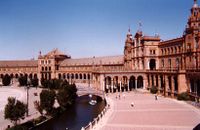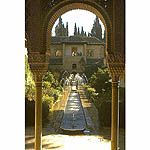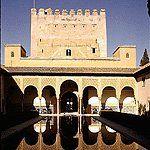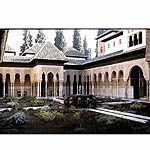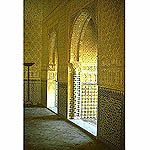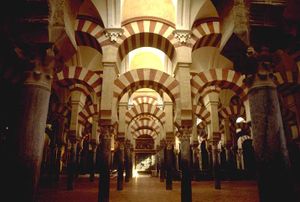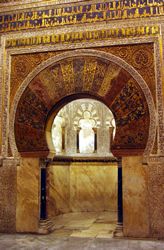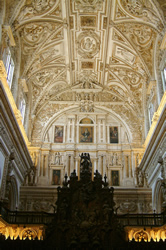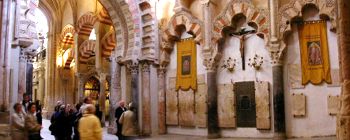Seville Photos
SEVILLA STUDY VISIT 2006 (5th-10th March 2006)
Quien no ha visto Sevilla, no ha visto maravilla – He who has not seen Sevilla, has not known wonderment. (old Sevilla saying)
DAY 1
Early on a wintry March morning, 38 students and staff from the Department of Sociology [led by Cecily Jones and Hazel Rice) left behind the windswept Warwick campus and for set off for southern Spain. Four hours later, still tired and sleep-deprived, we arrived at our destination, the city of Sevilla. Emerging bleary-eyed from the airport, we were all immensely cheered to find a city of orange trees, palms and sunshine, in stark contrast to the miserable weather we’d left behind in the UK – the first sun most of us had seen in months! I think we all considered this a good omen for the trip.
And our visit did get off to a good start, once we’d identified the correct coach to take us to the hotel. On our first evening, we split up into groups to explore the city, although arriving on a Sunday afternoon at the beginning of the Christian festival of Lent, many of the attractions and shops were closed, except for Burger King, of course, where some students had their first taste of Spanish cuisine. Some of us, however, had the equally bizarre experience of dining in a Spanish Chinese restaurant. As none of us could understand the baffling Spanish menu, we were fortunate in having Amy Evans on hand. Amy recognised the obscure Chinese dialect the staff were speaking, and ensured that everyone got the meal they wanted – just about.
WHY SEVILLA?
Sevilla is the capital city of Andalusia, the southernmost part of Spain, and generally acknowledged to be the most quintessentially Spanish region. It’s the fourth biggest city in Spain, described by Byron, chauvinistically, as ‘a, pleasant city, famous for its oranges and women”, but as we were to find, it offers far more than this; in fact it has a wealth of culture, a vibrant nightlife and a zest for living, as demonstrated by the locals’ passion for festivals and flamenco.
The region has over 3,000 years of history and the city itself is literally a living museum. Unlike previous years, we did not have any formal study, as efforts to persuade the Sociology Department at the University of Sevilla to organise lectures for us proved unsuccessful. Still, students and staff alike found that Sevilla’s rich and fascinating heritage offered an education in Spanish history. Though we only spent a total of two and a half days in the city, most agreed that it was a great choice for the visit. One student summed up the city as ‘simply magical!’
A SHORT HISTORY OF SEVILLA
Greek legend has it that Sevilla was founded by Hercules on six stone columns, but archeological evidence points to an early bronze age settlement (apparently built on wooden posts) some 10-11 centuries BCE. The early Iberians were later displaced, first by Phoenicians, then the Carthaginians and next the Romans after the battle of Illipa in 256 BCE during the Second Punic War. Nearby Itálica [the ruins of which can be seen today] became the first major Roman city in Spain - and the birthplace of the emperors, Trajan and Hadrian.
By about 50 BCE, Hispalis, as Sevilla was then known, had become one of the major cities of Bética (Roman Andalusia), and was Christianized during the later stages of the Empire. The city was sacked by the Vandals in 426 CE, and later came under the less violent regime of the Visigoths. The Moors took the city in 711, and transformed it into Isbiliya (from which the name Sevilla is derived). Islamic Isbiliya lasted until the Christian reconquest by Fernando III of Castilla in 1248.
The height of Sevilla's splendour came with Columbus’� s discovery of the New World. During the 16th and 17th centuries, Sevilla was the centre of operations during the Spanish expansion in the Americas. Its port was one of the most important in Spain, having the monopoly on trade with the New Worldcolonies. The intense trading activity in Sevilla during this period gave rise to a city filled with royal palaces, noble houses, churches and convents.
Sevilla was the home of famous and notorious historical figures: the legendary Don Juan learned the arts of seduction here before going on to conquer the hearts of women across Europe, while Columbus set off from a port close to Sevilla to discover the New World. Prosper Merimée's Carmen, who couldn't decide between the officer Don José and the bullfighter Escamillo - the consequences of which you can still enjoy today in the city opera house - was a worker in Sevilla's old tobacco factory. This factory serves today as a university, a fact that might give you a glimpse into the Andalusian talent for improvisation.
Spain's powerful world empire of the 16th and 17th centuries ultimately yielded command of the seas to Britain and other European powers. Subsequent failure to embrace the mercantile and industrial revolutions caused the country to fall further behind in terms of economic and political power. Spain remained neutral in World Wars I and II, but suffered through a devastating civil war (1936-39). In the second half of the 20th century, Spain played a catch-up role in the western international community, with new wealth founded on tourism, migrant workers and, ironically, a lucrative agreement that Franco negotiated with the United States allowing the latter to open military bases in Spain. In fact in 1966 a US warplane accidentally dropped four nuclear bombs on Spain , three of which landed near the tiny village of Palomares in eastern Andalusia, the fourth just off the coast. By some miracle none of them exploded.
Sevilla was immeasurably enriched when it hosted the World Fair in1992, coinciding with celebrations marking the fifth centenary of the European discovery of the Americas. The World Fair saw a return to a prominence and prosperity for Sevilla, not seen since its heyday in the 16th and 17th century.
Sevilla owes much of its charm to history, and you can see and feel elements of it throughout the city - the Roman ruins of Itálica, the Moorish, early Christian and New World expansion era architecture and monuments abound.
Today, Sevilla is often overshadowed by the more cosmopolitan cities of Madrid, Barcelona and even--thanks to an iconic Guggenhelm museum-- Bilbao. It's an injustice because Sevilla is a city rich in history and culture and home to some of the most stunning architectural monuments in the world. And as the birthplace of flamenco music and dance and the site of one the country's oldest bullrings [which we didn’t visit!] Sevilla is perhaps the most Spanish of Spain's historic cities and a must for any visitor to Iberia.
AMY, A MAP OF SEVILLA WOULD BE GOOD HERE – also perhaps a link to a site on Spanish history? And definitely one on SEVILLA’S HISTORY?
DAY 2
Events beyond our control forced a change of hotel, and finding one that could accommodate 38 of us at the drop of a hat was no mean feat, but eventually, the travel agents came through, and we moved to a far better hotel. The sight of a human crocodile of staff and students tramping through the city centre streets, dragging our luggage behind us, must have excited the curiosity of the Sevillanos. Fortunately for us, the second hotel had just been renovated - indeed, the builders were still on site – and we were the first guests. Although the transfer took up a good deal of time, we all agreed that it was a change for the better, as our new hotel was clean, safe and had excellent staff. Best of all though, it was located in the Barrio Santa Cruz [the former Jewish Quarter], a picturesque and delightful part of the Old City, with narrow, winding, cobbled streets; whitewashed houses; small squares lined with orange trees, many with beautiful patios; picturesque little parks and plazas; and innumerable tapas bars. The maze of improbably narrow alleys meant that getting lost was an experience shared by most of us!
The relocation meant that our planned programme got off to a late start, and activities planned for the first day were inevitably delayed or cancelled. By the time we had settled into our new hotel, it was late afternoon, and so the students enjoyed some free time. Many took the opportunity to acquaint themselves with the city centre, splitting up into small groups and going off to explore the parks, plazas and museums, before meeting up in the evening for our first group meal in Spain - in an Irish Bar!
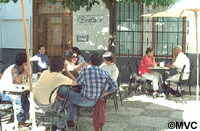
(Barrio Santa Cruz),
DAY 3
Evidence of its Moorish heritage can still be seen everywhere throughout the city, and we explored several of these sights, among them:
The stunning Sevilla Cathedral, once the site of a great Mosque, was begun in 1401 and grew to be the largest gothic cathedral in the world. In total the cathedral houses over 500 works of art, including a late 19th century monument to Cristobal Colon [Christopher Columbus to you]. A tomb in the Cathedral is the disputed final resting place of this explorer/adventurer whose misguided belief that he had discovered a new route to China led to the colonisation of the New World.
Amy please insert pics of Sevilla cathedral
View of Sevilla cathedral
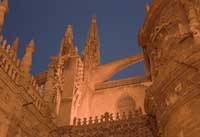
The Cathedral’s bell tower, the Giralda or Giraldillo, is in fact a minaret from the original mosque, and is one of the most important examples of Islamic architecture, not only in Spain, but in the world. The Giralda’s magnificent architecture represents the power and culture of the Almohad dynasty, which ruled Andalusia in the 12th century, and served as a model for similar bell towers at their imperial capitals of Rabat and Marrakech. It was used by the Moors both for calling the faithful to prayer (the traditional function of a minaret) and as an observatory, and was so venerated that they wanted to destroy it before the Christian conquest of the city. This they were prevented from doing by the threat of King Alfonso X that 'if they removed a single stone, they would all be put the sword'. The Giralda is one of the most beautiful buildings in Sevilla and dominates the skyline. Visitors can climb its 319 steps and I’m proud to say that most of our students managed to do so without mishap!
AMY, PLEASE INSERT PICS OF THE GIRALDA
The Torre del Oro or Golden Tower) was built between 1221 and 1222 and was one of the last contributions from the Almohad period in Sevilla. It formed part of the last wall of defence that ran from the Alcazar – a stunning fortress - to the river. It is said that the tower gained its name from the sun's reflection on its gold-leaf [reputedly imported from the Americas] tiles that once covered the dome. Today it houses the Naval Museum and all the gold has sadly been stolen.
The fortified Alcazar Palace (los Reales Alcácares),
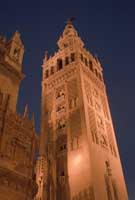
The Alcazar – cross between a castle, a palace and a fortress - was built on the orders of Muslim Caliph Abd Al Ramán III in the year 913. The architecture and decor are a mixture of Moorish/Gothic/Islamic. The work that went into the decoration just can't be comprehended. It’s apparently one of the oldest royal residences in Europe, and is still the residence of King Juán Carlos when he visits Sevilla. Throughout the years, many of its residents have added to the Alcazar, but most contemporary architects agree that the least attractive additions have to be those left by General Franco. The Generalissimo’s lasting legacy are the kitchens he had built to order! Today, he would have been able to go to the IKEA that has now opened on the outskirts of the city. Amy, you might wish to insert pics of the students at the Alcazar!
.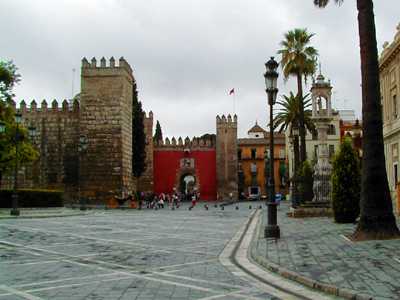
A view of the Alcazar
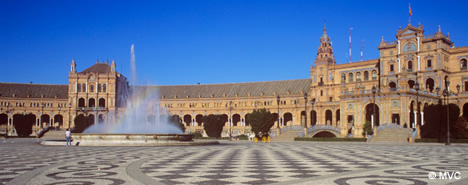
.
Views of the Plaza de Espana
The Plaza de España is one of Sevilla's most easily recognised buildings and the epitome of the Moorish Revival in Spanish architecture. In 1929 Sevilla hosted the Spanish-American Exhibition to showcase Spain’s industrial and technological achievements, and the Plaza de Espana was one of several buildings built to host the exhibition. The grandiose architecture is reminiscent of Muslim rule in the 8th and 9th centuries—when Sevilla was a great power in the Islamic Empire. It was constructed in a semi-circle around a large square. Set against the lower half of the building are 50 tiled benches symbolising Spain's 50 provinces. Every bench has a central pictorial panel of intricate Muslim tiles depicting a significant historical event from each province. They are placed in alphabetical order. Each province is separated by small alcoves designed to house a basic library on each province. Inside the building you can visit the spectacular patio with its two floors, arches and columns. Today the buildings around the plaza mainly house government departments.
A map of Sevilla in ceramic tiles at Sevilla's
famous Plaza de España. This map dates from around 1929 and is part
of a set of tileworks, each consisting of a map and historical
scene for each of Spain's provinces. 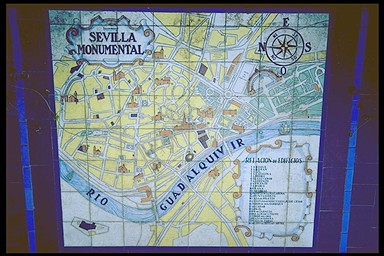
Near to the plaza is one of the city´s most beautiful open spaces, the Parque de Maria Luisa. The park covers some 400,000 square metres of woodland, water features and squares, which many students found to be a great place to enjoy their lunch.
The more energetic and studious of us also found time to visit the Archive of the Indies , one of the most important documentation centres relating to the conquest of the Americas. The Archives contain 36,000 files of documents chronicling the European discovery, colonization and administration of the New World, many of them testifying to Sevilla’s pivotal role in the conquest of the New World in the 16th century.
In the evening, most of us, tired out from the day’s sightseeing, enjoyed a leisurely boat-trip along the Rio Guadalqivir,the third longest river in Spain, and the longest in Andalusia. The name comes from the Arabic al-wādĩ al-kabir (الوادي الكبير), 'the big river'. The Guadalquivir is, remarkably, the only navigable river in Spain. Currently it is navigable up as far as Sevilla, though in Roman times it was possible for trading ships to reach the city of Córdoba.
Views of the Guadalquivir
River 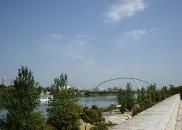

No stay in Sevilla is complete without taking in some Flamenco singing and dancing. After all, the city lays claim to being the birthplace of this art-form, said to have been created by gypsies in the city’s Triana district. Hazel was especially enthusiastic, and seriously considered flamenco as a new career, though we managed to talk her out of it.
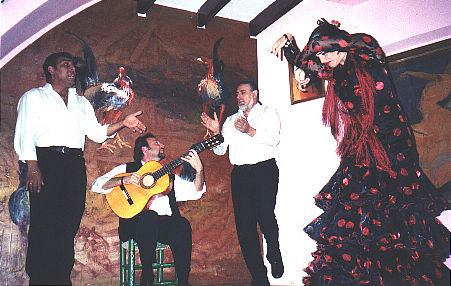
Hazel auditions for her new job – happily, for the Sociology Department, she wasn’t successful…!
DAY 4
An early morning start, as we set off for Granada where we planned to stay overnight. When the Romans colonised southern Spain, they built their own city here and called it Illibris. The Arabs, invading the peninsula in the 8th century, gave it its current name of Granada. It was the last Muslim city to fall to the Christians in 1492, at the hands of Queen Isabel of Castile and her husband Ferdinand of Aragon.
Granada’s most well-known attraction is the Alhambra Palace, so called because of its reddish walls (in Arabic, («qa'lat al-Hamra' orالحمراء = Al Ħamrā'), which means Red Castle).
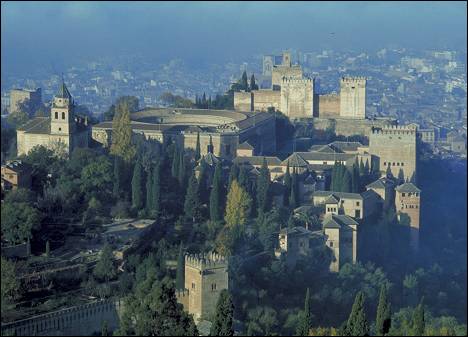
The Alhambra represents one of the most brilliant jewels of universal architecture. It is a series of palaces and gardens standing at the foot of Spain’s highest mountain range, the Sierra Nevada, and overlooks the city below and the fertile plain of Granada, the Vega. Built under the Nazari Dynasty in the 14th century, this mighty compound of buildings – including the delightful summer palace, the Generalife, with its fountains and gardens, was the residence of the Muslim kings of Granada and their court, but is currently a museum exhibiting exquisite Islamic architecture. The Alhambra is number 38 on the Wonders of the World listing.
Scenes of the Alhambra Palace
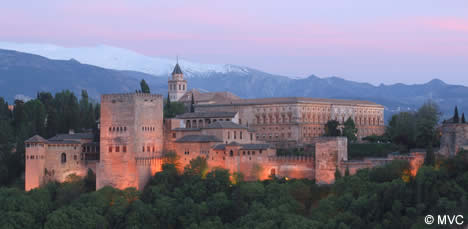
The Alhambra Palace and the backdrop of the magnificent Sierra Nevada mountain range
This was probably the most obvious study element of the trip. We had two excellent guides who were incredibly knowledgeable about the Moorish conquest of Spain, Islamic history and culture, and the history and architecture of the Alhambra itself. I think everyone came away feeling incredibly awed and lucky to have seen one of the most magnificent buildings in the world.
AMY, INSERT STUDENT’S COMMENTS [OR YOUR OWN!) ON THE ALHAMBRA
DAY 5
Back to Sevilla, via the city of Cordoba, where we spent the afternoon visiting another Moorish monument, the Mezquita. The Mezquita, (from Arabic مسجد "Masjid"), is Spanish for mosque.Córdoba's mosque is one of the earliest and most transportingly beautiful examples of Spanish Muslim architecture
The site is older than the building, having been host to a Roman pagan temple, the Visigothic cathedral church of St Vincent, and finally the Mezquita itself. Begun in the eighth century by Abd a-Rahman I, over the following two centuries the Moors enlarged and enhanced La Mezquita into a vast, magnificent house of worship. They creatively used a variety of architectural styles including Persian, Middle Eastern Islamic, Roman and Gothic, that together helped define Moorish architecture. The interior of the building is a myriad of row upon row of beautiful columns and horseshoe-shaped arches.. The Christians recaptured Cordoba in the 13th century and promptly consecrated the edifice as a church but left much of the superb Moor-erected architecture intact. The most significant alteration was the construction of a Renaissance cathedral nave in the middle of the structure. It was constructed by permission of Carlos V, Holy Roman Emperor and King of Spain; though once he saw what had been built, he is said to have expressed his dismay with the words, "You have built what you or others might have built anywhere, but you have destroyed something unique in the world." However, the addition of the cathedral nave is believed to have reinforced the edifice's structural stability, and its consecration as a Christian church may have helped to preserve it when the Spanish Inquisition was most active.
![]() Today, the building is peacefully divided
between Muslims and Catholics (who still use the bizarrely situated
cathedral).
Today, the building is peacefully divided
between Muslims and Catholics (who still use the bizarrely situated
cathedral).
AMY, COULD WE GET A STUDENT’S COMMENT ON THE ALHAMBRA AND THE MEZQUITA – TRY SARAH KILOU AND SHANZIDAR SHAH AND TELL THEM THAT I’VE ESPECIALLY ASKED FOR THEIR COMMENTS
Interior views of the Mezquita: The inside of Cordoba's Mezquitais a forest of red-and-white striped columns, glittering walls and ceilings... and a Baroque cathedral plunked right in the middle!
We arrived back in Sevilla in time for dinner – and decided to make the most of our final evening by holding the very last SSLC meeting of the year – the venue proved much better than the Sociology Common Room or the GRSR - the tapas bar opposite our hotel which we took over for the evening. (A very wise choice of location as it meant that we only had to stumble across the alleyway to our beds!) As was to be expected, not much SSLC business was conducted, but as it was our final evening, we had a great deal of fun, thanks to Juan-Pedro, the barman-cum-host, who courageously agreed to supply us with wine, beer and food for the evening. We had a team quiz to test students’ knowledge of Andalusian culture, which was won by the “clever team”. Hazel and Amar entertained us with their newly-acquired flamenco skills. The students kindly presented staff with souvenirs of the visit, and we were really touched by this gesture.
AMY, pictures of Hazel and Amar dancing
DAY 6
Yet another early morning start, though this time, the destination was not very eagerly anticipated – the end of our trip, and it’s back to wet, rain-washed, dreary Warwick via Heathrow.
OVERVIEW
Sevilla was a real educational experience for all of us, especially for those visiting the city for the first time. Few of us had any Spanish language at the start, but intrepid adventurers that we were, we didn’t let that deter us! Within hours of our arrival, just about everyone had learned the Spanish for two of the most important words in the student lexicon – cerveza – [that’s beer] and vino blanco [white wine] . Many thanks to Amar Wahab and Ian Jones for acting as impromptu translators and interpreters throughout.
Happily, we didn’t lose any students – though one unfortunate student lost her childhood toy, and we nearly lost Hazel to the world of Flamenco, no-one got into trouble with the very overzealous Spanish police – though an unfortunate episode meant that we also learned the Spanish term for police station (though, on this occasion, Hazel didn’t get to ride in a police car, but she did get to spend part of the first night with members of the local Guardia Civil – though she was accompanied by Paul Birch, Ian Jones and Amar Wahab!). There were some very eventful moments – such as our arrival at Heathrow to find that half of the group’s baggage had been left behind at Sevilla airport, though, happily, it was soon returned to the rightful owners. Overall, I was tremendously impressed by the way in which the students took the more potentially stressful events in their stride, and moreover, really enjoyed learning about Sevilla’s history and culture. From my perspective, it was also a great time to get to know students that I hadn’t previously taught, or just to catch up with past students, many of whom were finalists, and whom I would not see again after our return. .
Overall, the general consensus was that Sevilla was an excellent choice -not least of all because most students returned with a suntan when most of the UK was still shrouded in mist and cold!
Finally, huge thanks to Hazel Rice, who is truly one of the world’s greatest unsung administrators, Amy Evans, Ian Jones and Amar Wahab, and all the students, each of whom, in their own way helped to enrich our time in Sevilla, Granada and Cordoba.

